The demand for food grade dipotassium phosphate in the USA is expected to grow from USD 1.1 billion in 2025 to USD 1.7 billion by 2035, reflecting a CAGR of 4.7%. Food grade dipotassium phosphate is commonly used as a buffering agent, emulsifier, and nutrient supplement in various food products, including dairy, beverages, processed foods, and baked goods. The growth in demand for this product is driven by increasing consumer preference for processed and convenience foods, which require effective preservation, texture improvement, and nutritional fortification. The expansion of the food and beverage industry, particularly in plant-based alternatives and functional foods, will further support the demand for food-grade dipotassium phosphate.
Technological advancements and regulatory approvals supporting the use of dipotassium phosphate in food applications will also be significant growth drivers. Additionally, the growing focus on food safety, quality control, and product consistency will lead manufacturers to increase their usage of stabilizers and emulsifiers such as dipotassium phosphate to maintain high product standards. As the market becomes more diversified and accessible, the increasing use of food-grade ingredients in various formulations will further contribute to the growth of dipotassium phosphate consumption in the USA.

The acceleration and deceleration pattern for food grade dipotassium phosphate in the USA shows steady growth, with periods of acceleration followed by slower deceleration as the market matures.
From 2025 to 2030, the market will grow from USD 1.1 billion to USD 1.3 billion, contributing an increase of USD 0.2 billion. This early phase will experience acceleration in demand, driven by increasing adoption of dipotassium phosphate in processed foods, dairy products, and beverages. The expanding market for plant-based alternatives and the growing focus on nutritional enhancement and food safety will drive the increased use of this ingredient. As food manufacturers prioritize product consistency and stability, the growth in demand will accelerate in the early years, with increasing applications across multiple segments in the food and beverage industry.
From 2030 to 2035, the market will grow from USD 1.3 billion to USD 1.7 billion, adding USD 0.4 billion in value. While the growth continues in this phase, the rate of acceleration will slow down slightly, as the market begins to reach maturity. The deceleration in growth will be driven by a stabilization in the adoption rate of dipotassium phosphate, as the ingredient becomes more standardized in food products. However, demand will remain strong due to continued growth in functional foods, beverages, and nutritional supplements, ensuring steady expansion despite a more moderate growth rate.
| Metric | Value |
|---|---|
| Industry Sales Value (2025) | USD 1.1 billion |
| Industry Forecast Value (2035) | USD 1.7 billion |
| Industry Forecast CAGR (2025-2035) | 4.7% |
Demand for food grade dipotassium phosphate (DKP) in the USA is increasing as food and beverage manufacturers seek multifunctional additives that enhance texture, stability, and shelf life in processed foods. DKP is used as a buffering agent, emulsifier, and nutrient source in products such as dairy, bakery, meat, and beverage applications. With the USA market for processed foods continuing to grow, the requirement for reliable functional ingredients supports increased use of DKP. For example, North America holds a significant share of the global DKP market, driven by high consumption of processed food in the region.
Another factor supporting demand is the trend toward fortified, nutrient enhanced foods and clean label formulations. DKP offers potassium and phosphorus—elements valued in nutritional labeling—which appeals to manufacturers of dietary supplements and functional foods. Technological advances in food processing also enable incorporation of DKP in new formats, expanding its role in meat products, dairy alternatives, plant based beverages, and nutritional snacks. However, challenges such as raw material price volatility, regulatory scrutiny of food additives, and competition from alternative ingredients may temper growth. Despite these constraints, the role of DKP as a versatile food additive ensures steady growth of demand in the USA market.
The demand for food grade dipotassium phosphate in the USA is primarily driven by form and application. The leading form is powder, holding 64% of the market share, while the dominant application is dairy, accounting for 36.2% of the demand. Food grade dipotassium phosphate is widely used as an emulsifying agent, stabilizer, and acidulant in various food products. Its versatility and effectiveness in enhancing the texture, shelf life, and overall quality of food products contribute to its strong demand across multiple sectors.

Powder form leads the demand for food grade dipotassium phosphate in the USA, accounting for 64% of the market share. The powder form is preferred due to its ease of incorporation into various food products, especially in the dairy and beverage industries. It can be easily dissolved in water or mixed into other ingredients, making it highly suitable for large-scale production processes.
The popularity of powdered dipotassium phosphate is driven by its ability to improve the texture and consistency of products, especially in emulsification processes. It helps stabilize fats and water in products like dairy, sauces, and beverages, ensuring a smooth and uniform texture. Additionally, the powder form is easy to store and handle, which contributes to its widespread use in food manufacturing. As the demand for functional ingredients in processed food continues to grow, powdered dipotassium phosphate is expected to maintain its dominant position in the market.
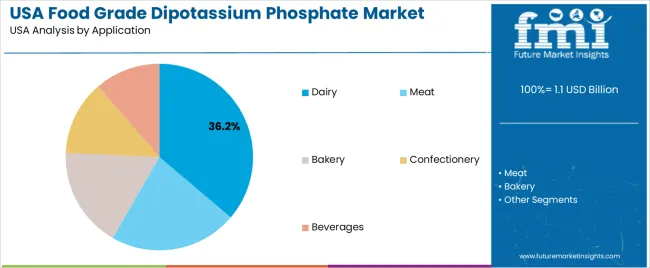
Dairy is the leading application segment for food grade dipotassium phosphate in the USA, capturing 36.2% of the demand. Dipotassium phosphate is widely used in dairy products for its role in emulsifying and stabilizing products like milk, cheese, and yogurt. It helps to improve texture, prevent separation, and extend shelf life by maintaining the homogeneity of the product during storage and transportation.
The demand from the dairy industry is driven by the growing need for processed and convenience dairy products, which often require the addition of stabilizers and emulsifiers to enhance product quality. Dipotassium phosphate’s ability to improve the consistency and prevent the formation of undesirable textures, such as curdling, makes it essential in the production of a wide range of dairy products. As consumer demand for high-quality, shelf-stable dairy products continues to rise, the demand for food grade dipotassium phosphate in the dairy sector is expected to remain strong, further driving its dominance in this application.
Demand for food grade dipotassium phosphate (DKP) in the USA is shaped by the growing consumption of processed and convenience foods, the need for stabilisers and buffers in dairy, bakery and meat processing, and greater focus on functional ingredients in the food and beverage industry. At the same time, the high cost of raw materials, regulatory scrutiny of additives and competition from alternative ingredients moderate growth. These combined forces determine how DKP is used and its future uptake in the USA food grade additive market.
What Are the Primary Growth Drivers for Food Grade Dipotassium Phosphate Demand in the United States?
Several drivers support USA demand. First, the rise in processed foods and ready to eat meals creates more requirement for additives that stabilise texture, regulate pH and extend shelf life, roles that DKP fulfils. Second, the growing dairy and meat processing sectors rely on phosphate additives like DKP for quality and operational benefits. Third, clean label and functional ingredient trends encourage use of mineral based additives such as DKP in fortified foods and beverages. Fourth, food manufacturers seek consistent, high purity ingredients to meet regulatory standards and consumer expectations, benefiting DKP suppliers.
What Are the Key Restraints Affecting Food Grade Dipotassium Phosphate Demand in the United States?
Despite favourable conditions, some restraints exist. Raw material volatility and rising costs of phosphate based chemicals can raise production cost of DKP, limiting price competitiveness. Regulatory concerns and consumer scrutiny of food additives may reduce willingness by some manufacturers to use phosphate salts broadly. Substitution risk from alternative stabilisers and buffers may constrain DKP adoption in certain applications. Finally, maturity of certain end markets (such as basic dairy or bakery products) may limit incremental growth for DKP in some segments.
What Are the Key Trends Shaping Food Grade Dipotassium Phosphate Demand in the United States?
Important trends include increased use of DKP in plant based dairy alternatives and fortified beverages, where texture and buffering are important. There is growing emphasis on clean label and mineral rich ingredient positioning, with DKP being leveraged for its potassium and phosphorus content in functional foods. Manufacturers are also formulating more customised DKP grades with improved solubility and compatibility for diverse food systems. Sustainability and supply chain transparency are gaining importance, prompting manufacturers to source and certify phosphate additives with lower environmental footprint.
The demand for food-grade dipotassium phosphate (DKP) in the USA is driven by its widespread use as a food additive, buffering agent, emulsifier, and stabilizer. DKP is commonly used in the food and beverage industry to improve the texture, taste, and shelf-life of products such as dairy products, processed foods, and beverages. The rising consumer demand for processed and convenience foods, along with the increasing awareness of food preservation techniques, drives the adoption of DKP. Additionally, DKP is used in the production of sports drinks, dairy products, and processed meats, further fueling its demand. Regional differences in demand are influenced by local food manufacturing activity, population health trends, and industrial production in various areas. Below is an analysis of the demand for food-grade dipotassium phosphate across different regions in the USA.
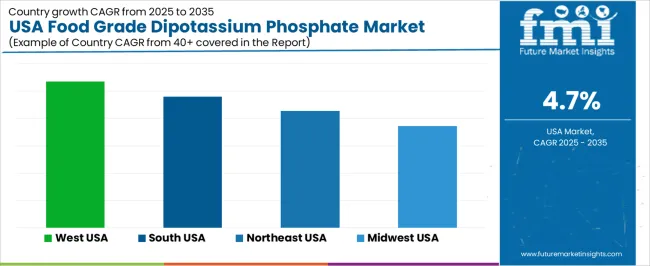
| Region | CAGR (2025-2035) |
|---|---|
| West | 5.4% |
| South | 4.8% |
| Northeast | 4.3% |
| Midwest | 3.7% |
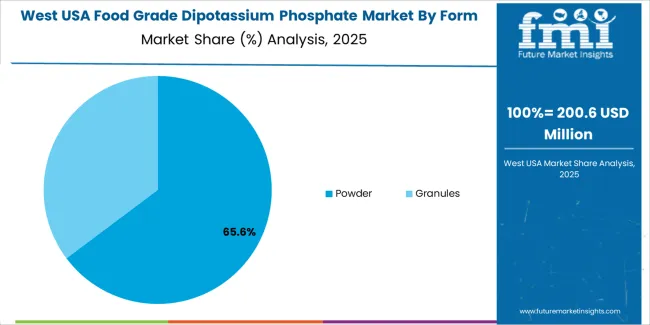
The West leads the demand for food-grade dipotassium phosphate in the USA with a CAGR of 5.4%. This can be attributed to the region’s large food processing industry, particularly in states like California, Oregon, and Washington, which are major hubs for food manufacturing and beverage production. The West's strong focus on food innovation, sustainability, and technological advancements in food preservation also drives the demand for additives like DKP that help maintain product quality and shelf life.
Moreover, the growing consumer preference for ready-to-eat, processed, and health-oriented food products in the West further fuels the demand for food-grade dipotassium phosphate. The region's high production of dairy, beverages, and sports nutrition products, all of which commonly use DKP as an additive, supports the strong growth of the market. Additionally, the West's large population and diverse food preferences contribute to increased consumption of food-grade additives like DKP.

The South shows strong demand for food-grade dipotassium phosphate with a CAGR of 4.8%. The region has a significant food manufacturing sector, particularly in states like Texas, Florida, and Georgia, where large-scale production of dairy products, processed foods, and beverages occurs. As these industries grow, so does the demand for food additives like DKP that help improve product stability, taste, and texture.
The South also has a growing population with an increasing demand for packaged and processed foods, which further supports the need for preservatives and stabilizers such as dipotassium phosphate. The increasing consumption of dairy products and ready-to-drink beverages, including sports and energy drinks, which often contain DKP, also contributes to the region's strong market growth.
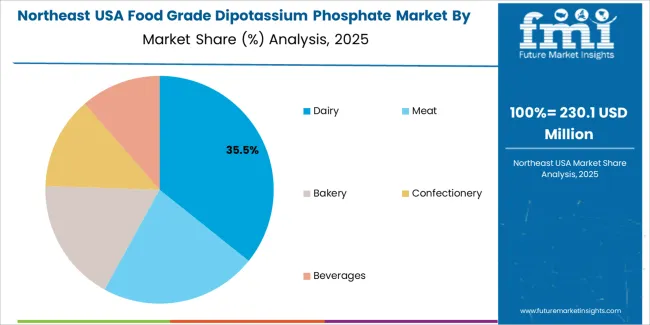
The Northeast shows steady demand for food-grade dipotassium phosphate with a CAGR of 4.3%. The region is home to a well-established food and beverage industry, particularly in urban areas like New York, Pennsylvania, and Massachusetts. The growing demand for processed foods, convenience products, and beverages in this region drives the continued need for additives like DKP.
Although the Northeast has a more mature market compared to the West and South, its strong food manufacturing infrastructure ensures a steady demand for food-grade dipotassium phosphate. The region's growing interest in health-conscious and functional foods, such as dairy alternatives and fortified beverages, also contributes to market stability, as DKP is often used in these products for improved texture and stability.
The Midwest shows moderate growth in the demand for food-grade dipotassium phosphate with a CAGR of 3.7%. The region has a large agricultural and food processing base, especially in states like Illinois, Ohio, and Michigan, where the production of dairy, meat, and grain-based products is significant. While the Midwest’s demand for food-grade additives like DKP is growing, it is relatively slower compared to other regions due to a lower concentration of food and beverage manufacturing hubs focused on processed products.
However, as consumer demand for packaged foods, snacks, and beverages continues to rise in the Midwest, the demand for food-grade dipotassium phosphate will increase. Additionally, the region's focus on enhancing food quality and shelf-life through preservatives and stabilizers ensures continued adoption of DKP. As food manufacturing continues to evolve with more innovative products, the Midwest is expected to see gradual growth in the demand for food-grade dipotassium phosphate.
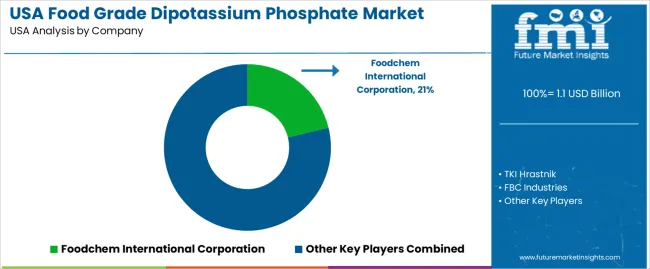
The demand for food grade dipotassium phosphate in the United States is growing due to its increasing use as a stabilizer, emulsifier, and buffering agent in food and beverage products. Companies like Foodchem International Corporation (holding approximately 21.2% market share), TKI Hrastnik, FBC Industries, Aditya Birla Chemicals, and Haifa Chemicals Ltd. are key players in this industry. Food grade dipotassium phosphate is commonly used in processed foods, dairy products, beverages, and meat products for enhancing texture, improving nutrient absorption, and extending shelf life.
Competition in this market is primarily driven by product quality, regulatory compliance, and supply chain reliability. Companies focus on ensuring that their dipotassium phosphate products meet the stringent quality standards set by the FDA and other regulatory bodies. Another area of competition is the ability to offer high-purity products that are free of contaminants and suitable for a wide range of food applications. Suppliers are also focusing on sustainability and providing products that align with growing consumer demand for cleaner labels and environmentally friendly production processes. Marketing materials often highlight features such as food safety, compliance with industry regulations, and the versatility of dipotassium phosphate in different food products. By aligning their offerings with the increasing demand for high-quality, reliable, and sustainable food ingredients, these companies aim to strengthen their position in the USA food grade dipotassium phosphate market.
| Items | Details |
|---|---|
| Quantitative Units | USD Billion |
| Regions Covered | USA |
| Form | Powder, Granules |
| Product Type | Dipotassium Phosphate Anhydrous, Dipotassium Hydrogen Phosphate Trihydrate, Dipotassium Phosphate Used in Coffee Mate, Potassium Phosphate Dibasic, Dipotassium Hydrogen Phosphate |
| Application | Dairy, Meat, Bakery, Confectionery, Beverages |
| End User | Individuals, Industrial, Foodservice |
| Key Companies Profiled | Foodchem International Corporation, TKI Hrastnik, FBC Industries, Aditya Birla Chemicals, Haifa Chemicals Ltd. |
| Additional Attributes | The market analysis includes dollar sales by form, product type, application, and end-user categories. It also covers regional demand trends in the USA, particularly driven by the increasing use of dipotassium phosphate in dairy, meat, and bakery products. The competitive landscape highlights key manufacturers focusing on innovations in food-grade dipotassium phosphate for different applications. Trends in the growing demand for processed food and beverages, as well as the role of dipotassium phosphate in enhancing product quality and stability, are explored. |
The global demand for food grade dipotassium phosphate in USA is estimated to be valued at USD 1.1 billion in 2025.
The market size for the demand for food grade dipotassium phosphate in USA is projected to reach USD 1.7 billion by 2035.
The demand for food grade dipotassium phosphate in USA is expected to grow at a 4.7% CAGR between 2025 and 2035.
The key product types in demand for food grade dipotassium phosphate in USA are powder and granules.
In terms of application, dairy segment to command 36.2% share in the demand for food grade dipotassium phosphate in USA in 2025.






Our Research Products

The "Full Research Suite" delivers actionable market intel, deep dives on markets or technologies, so clients act faster, cut risk, and unlock growth.

The Leaderboard benchmarks and ranks top vendors, classifying them as Established Leaders, Leading Challengers, or Disruptors & Challengers.

Locates where complements amplify value and substitutes erode it, forecasting net impact by horizon

We deliver granular, decision-grade intel: market sizing, 5-year forecasts, pricing, adoption, usage, revenue, and operational KPIs—plus competitor tracking, regulation, and value chains—across 60 countries broadly.

Spot the shifts before they hit your P&L. We track inflection points, adoption curves, pricing moves, and ecosystem plays to show where demand is heading, why it is changing, and what to do next across high-growth markets and disruptive tech

Real-time reads of user behavior. We track shifting priorities, perceptions of today’s and next-gen services, and provider experience, then pace how fast tech moves from trial to adoption, blending buyer, consumer, and channel inputs with social signals (#WhySwitch, #UX).

Partner with our analyst team to build a custom report designed around your business priorities. From analysing market trends to assessing competitors or crafting bespoke datasets, we tailor insights to your needs.
Supplier Intelligence
Discovery & Profiling
Capacity & Footprint
Performance & Risk
Compliance & Governance
Commercial Readiness
Who Supplies Whom
Scorecards & Shortlists
Playbooks & Docs
Category Intelligence
Definition & Scope
Demand & Use Cases
Cost Drivers
Market Structure
Supply Chain Map
Trade & Policy
Operating Norms
Deliverables
Buyer Intelligence
Account Basics
Spend & Scope
Procurement Model
Vendor Requirements
Terms & Policies
Entry Strategy
Pain Points & Triggers
Outputs
Pricing Analysis
Benchmarks
Trends
Should-Cost
Indexation
Landed Cost
Commercial Terms
Deliverables
Brand Analysis
Positioning & Value Prop
Share & Presence
Customer Evidence
Go-to-Market
Digital & Reputation
Compliance & Trust
KPIs & Gaps
Outputs
Full Research Suite comprises of:
Market outlook & trends analysis
Interviews & case studies
Strategic recommendations
Vendor profiles & capabilities analysis
5-year forecasts
8 regions and 60+ country-level data splits
Market segment data splits
12 months of continuous data updates
DELIVERED AS:
PDF EXCEL ONLINE
Food Grade Dipotassium Phosphate Market Analysis by Dipotassium Phosphate Anhydrous, Dipotassium Hydrogen Phosphate Trihydrate, Dipotassium Phosphate Used in Coffee Mate, Potassium Phosphate dibasic and Dipotassium Hydrogen Phosphate Through 2035
Demand for Food Grade Dipotassium Phosphate in Japan Size and Share Forecast Outlook 2025 to 2035
Analysis and Growth Projections for Food Grade Phosphate Business
United States Food Emulsifier Market Trends – Growth, Demand & Forecast 2025–2035
USA Food Service Industry Analysis from 2025 to 2035
USA Food Testing Services Market Outlook – Share, Growth & Forecast 2025–2035
USA Food Stabilizers Market Analysis – Size, Share & Forecast 2025–2035
USA Food Service Equipment Market Insights – Demand, Size & Industry Trends 2025–2035
USA Food Hydrocolloids Market Trends – Size, Share & Growth 2025-2035
Food Grade Crosslinked Polyvinylpolypyrrolidone (PVPP) Market Size and Share Forecast Outlook 2025 to 2035
Food Grade Cassia Gum Powder Market Size and Share Forecast Outlook 2025 to 2035
Food Grade Dry Film Lubricant Market Size and Share Forecast Outlook 2025 to 2035
Food Grade Tremella Polysaccharide Market Size and Share Forecast Outlook 2025 to 2035
Food Grade Solvent Market Analysis - Size and Share Forecast Outlook 2025 to 2035
Food Grade Industrial Gases Market Size and Share Forecast Outlook 2025 to 2035
Food-Grade Mixing Tank Market Size and Share Forecast Outlook 2025 to 2035
Food Grade Glass Market Analysis - Size, Share, & Forecast Outlook 2025 to 2035
Food Grade Gas Market Analysis - Size, Share, and Forecast Outlook 2025 to 2035
Food Grade Antifoams Market Size, Growth, and Forecast for 2025 to 2035
Analysis and Growth Projections for Food Grade Carrageenan Market

Thank you!
You will receive an email from our Business Development Manager. Please be sure to check your SPAM/JUNK folder too.
Chat With
MaRIA